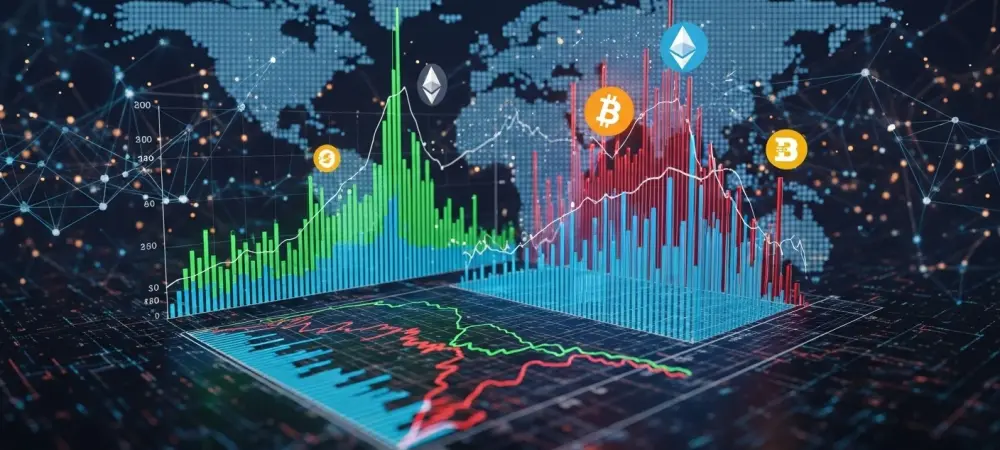Today, we’re thrilled to sit down with Dominic Jainy, an IT professional whose deep expertise in artificial intelligence, machine learning, and blockchain technology has made him a sought-after voice in the crypto space. With a keen interest in how these technologies shape industries, Dominic offers unique insights into the volatile world of cryptocurrency. In this conversation, we dive into the latest market trends, from Bitcoin’s critical price levels to the surprising resilience of XRP amid a broader downturn, as well as the impact of institutional moves and emerging regulatory landscapes.
Can you walk us through what’s driving the current downturn in the crypto market?
Absolutely. What we’re seeing right now is a classic case of market consolidation after a period of strong gains. A lot of investors who bought in at lower prices are taking profits off the table, which creates selling pressure. On top of that, there’s a layer of uncertainty—whether it’s macroeconomic factors like interest rate concerns or just the crypto market’s inherent volatility—that’s making people hesitant. This combination often triggers pullbacks like the one we’re experiencing today, where Bitcoin and altcoins alike are trading in the red.
How significant is it that Bitcoin is still holding above the $100,000 mark despite a 2.44% drop to $107,721.81?
It’s incredibly significant. The $100,000 level isn’t just a number—it’s a psychological barrier for traders and investors. Staying above it signals resilience and maintains confidence in Bitcoin as a store of value, often referred to as ‘digital gold.’ It shows that even with profit-taking and market jitters, there’s still strong underlying demand. If Bitcoin were to dip below this level, though, it could trigger panic selling and test lower support zones, so holding here is a critical sign of stability for now.
Ethereum seems to be under heavier pressure, down nearly 5% to $3,849.04. Why do you think altcoins like Ethereum are getting hit harder than Bitcoin right now?
That’s a pattern we often see in crypto markets. Bitcoin tends to be the benchmark, and when it faces downward pressure, altcoins like Ethereum usually amplify that movement because they’re perceived as riskier assets. Investors often flock to Bitcoin as a safer bet during uncertainty, pulling capital away from altcoins. Additionally, Ethereum might be facing specific headwinds—perhaps concerns over network upgrades or staking yields—that aren’t affecting Bitcoin to the same degree. It’s a mix of market dynamics and asset-specific sentiment.
On the flip side, XRP is showing relative strength, down just 0.5% to $2.42. What’s behind this resilience compared to other major cryptocurrencies?
XRP’s performance right now is largely tied to positive news in the ecosystem. The announcement of a digital asset firm planning a $1 billion public listing and building a massive XRP treasury has caught the market’s attention. This kind of institutional interest boosts confidence, signaling that big players see long-term value in XRP. While the broader market is in a slump, this development acts as a counterbalance, keeping XRP’s losses minimal compared to peers like Ethereum or Solana.
Speaking of other altcoins, Solana and BNB have seen steeper declines—4.44% and 5.36%, respectively. What’s driving these bigger losses compared to Bitcoin or XRP?
Solana and BNB are often more sensitive to shifts in investor sentiment because they’re tied to specific ecosystems with high growth potential but also higher perceived risk. When the market consolidates, as it is now, speculative assets like these tend to see outsized selling. For Solana, despite strong trading volumes, there might be concerns about scalability or competition in the smart contract space. BNB, tied to a major exchange’s ecosystem, could be reflecting broader fears about regulatory scrutiny on centralized platforms. It’s a combination of market-wide caution and project-specific factors.
Let’s zoom in on the news about the $1 billion public listing tied to XRP. How do you see this kind of institutional involvement shaping the future of cryptocurrencies like XRP?
This is a game-changer. When institutions commit to something like building a massive XRP treasury, it’s a strong vote of confidence in the asset’s utility and future adoption. It’s not just about the money—it’s about the signal it sends to other investors and companies. This move could accelerate XRP’s integration into traditional finance, especially if it’s listed on major stock exchanges. Beyond XRP, it sets a precedent for how institutional capital can legitimize and stabilize cryptocurrencies, potentially paving the way for more widespread use in payments and beyond.
With regulatory developments—like proposals to make New York City a hub for blockchain—how do you think clearer policies could impact the crypto market in the long term?
Regulatory clarity is one of the biggest catalysts the crypto market needs right now. Proposals to position major cities as blockchain hubs, with dedicated innovation councils and eased regulations, could transform the industry. It would encourage institutional investment, foster startups, and build trust among retail investors who are wary of legal gray areas. Long term, this could mean less volatility and more mainstream adoption, as businesses feel safer building on blockchain tech. It’s not just about price—it’s about creating a sustainable ecosystem.
What’s your forecast for the crypto market in the coming months, especially with key support levels and institutional developments in play?
I’m cautiously optimistic. If Bitcoin can hold above $100,000 and we see continued institutional interest—like the XRP treasury news or pro-crypto policies in major cities—I think we could see a recovery and possibly new highs by early next year. However, there are risks. A break below key support levels could lead to a deeper correction, especially if macroeconomic conditions worsen. I’d also keep an eye on trading volumes; sustained high activity, even during dips, suggests the market hasn’t lost its appetite. It’s a delicate balance, but the fundamentals for growth are still there if the right catalysts align.

